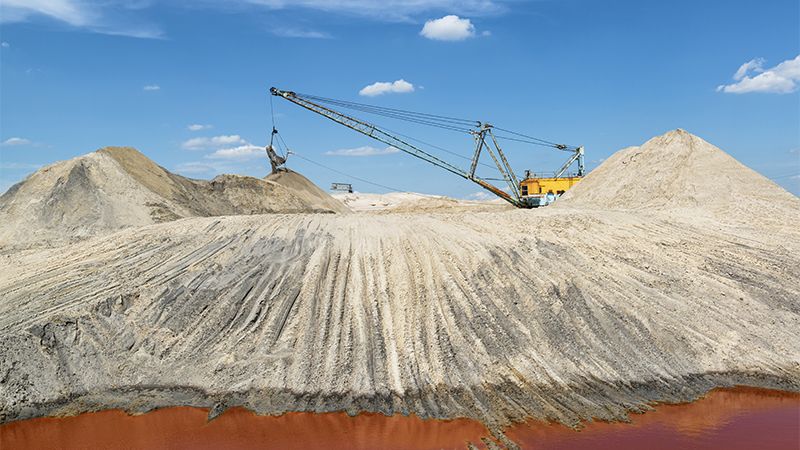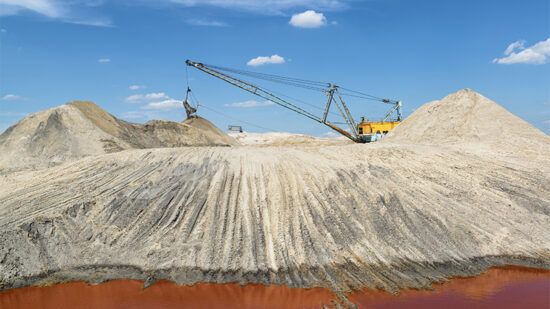Donald Trump’s transactional style has ushered in a new era for geopolitics and markets alike. Discussions over a US-Ukraine mineral deal, which the US president claims would provide security to Ukraine at the cost of access to its deposits, has been a feature of Trump’s rhetoric since beginning his second term.
The deal could have a significant impact on global commodity markets, with Ukraine home to various mineral deposits, including titanium, lithium, uranium and graphite.
Hakan Kaya, senior portfolio manager of the Neuberger Berman Commodities Ucits fund, says at face value, the US-Ukraine mineral deal might seem like it is creating supply out of thin air, which could be bearish for commodities.
“The reality is more complex, with both short- and long-term implications that could actually tighten markets and support prices.
“If this deal helps pave the way for a broader truce, one immediate effect could be the removal of sanctions or price caps on Russian oil. Right now, discounted Russian crude has been a major factor in keeping global prices in check. If that discount disappears, Russia would sell at market rates, potentially pushing oil prices higher.”
Both Russia and Ukraine have aggressively exported other commodities such as grain to finance their war efforts. Kaya adds that a ceasefire could reduce the pressure to sell, leading to a slowdown in supply and firmer prices in wheat and corn markets.
Longer term, Ukraine’s reconstruction would likely drive demand for industrial commodities such as steel, cement and energy, adding another layer of price support.
“Another key factor is risk sentiment,” according to Kaya. “A de-escalation of the war would likely improve market confidence, reducing risk aversion and encouraging investment. In Europe, where businesses have been cautious in stockpiling raw materials due to economic uncertainty, this shift in sentiment could lead to renewed physical restocking. That, in turn, could tighten inventories across key commodity markets, from metals to energy.
“Then there’s the long-term impact on critical minerals. Ukraine holds significant reserves of lithium, titanium and rare earth elements – key inputs for batteries, aerospace and defence. If this deal strengthens US access to these materials, it could reduce supply-chain risks, making investment in commodity-intensive sectors more attractive and driving sustained demand growth.
“So while an initial glance might suggest an oversupply risk, the bigger picture points to a scenario where improving risk appetite, shifting trade flows and renewed economic activity actually tighten commodity markets rather than weaken them.”
Security, but more volatility?
The politics of the deal could shape future markets as well. George Cotton, portfolio manager of the JSS Transition Enhanced Commodities fund, says the deal reflects “a new reality”, centred around Trump’s transactional approach to geopolitics.
He adds the deal would send a signal that using supply chains to achieve geopolitical or domestic agendas is “fair game with allies or foes alike”.
“This dramatically increases geopolitical risk and suggests we are likely to see more volatility in global commodity markets in coming years.”
The minerals deal is “intriguing” as Ukraine lacks large and economically viable deposits of critical minerals that could be developed by major mining companies, adds Cotton, particularly compared with ongoing projects in North America.
“Soviet-era geologists estimated the magnitude of potential deposits during the 1980s, but there has been little development of the country’s mining industry since then, apart from iron ore, coal, manganese and titanium.
“With the total value of these exports not exceeding $10bn [£7.7bn] prior to the 2022 invasion, the passage of the deal is significant from a political perspective for two reasons. First, it signals both Ukraine’s willingness to re-engage with the Trump administration, and second, it ushers in an era of ‘transactional’ geopolitics, a far cry from the norms-based order that has prevailed over the past half-century.”
Away from the minerals deal, trade war fears have shaped markets in the opening quarter of 2025. This is likely to continue to impact commodity markets.
As J Safra Sarasin’s Cotton notes, tariffs have already caused major movements of material into the US (as a major importer) in order to pre-empt tariffs, which has driven large inter-regional price differentials, while metals prices have spiked.
US agricultural markets, which are major exporters, have sold off on fears of retaliatory tariffs.
“As we re-enter a world of ‘policy by tweet’, such large swings are likely to be a feature of the next few years,” Cotton explains.
Kaya, however, argues tariffs could actually be a tailwind for the asset class.
“Tariffs do not exist in a vacuum – it takes two to tango in a trade war, and how other nations respond is just as important. A tariff-burdened world could reshape demand in ways that actually support commodity markets.
“One potential outcome is a major Chinese stimulus,” according to Kaya. “If China retaliates against US tariffs, it may counter with aggressive fiscal and monetary easing, particularly in sectors where it wants to maintain global leadership – such as renewable energy, electric vehicles and high-tech manufacturing. That could drive a surge in restocking for industrial metals like copper and aluminium, reinforcing demand across the broader commodity complex.”
A similar fiscal and monetary expansion could also take place in Europe, with Germany already announcing reforms to its debt brake amid large-scale spending on defence and infrastructure.
“The region has been grappling with a manufacturing recession for years, and increased government spending on infrastructure and industrial revival could boost business confidence, strengthening demand for metals, energy and other raw materials,” Kaya says.
“Another key shift could be the acceleration of ex-US trade alliances. If tariffs weaken US trade relationships, countries may look to deepen economic ties elsewhere – strengthening trade blocs that bypass the US.
“This could sustain global commodity demand even if the US economy slows. At the same time, reduced reliance on the US dollar in international trade could bolster demand for alternative stores of value such as gold and silver, fuelling de-dollarisation plays.
“While tariffs introduce uncertainty and potential disruptions, they could also lead to policy responses that stimulate demand, tighten inventories and reinforce the long-term case for commodities as a strategic asset class.”
A golden hedge
With markets increasingly tense as a result of trade wars, investors have sought shelter in gold. The move has paid off so far, with gold breaking the $3,000 barrier in March, while the SPDR Gold Trust ETF is up 38.65% for the year to 1 April.
Historically, investors have used gold as a hedge against inflation. Neuberger Berman’s Kaya says the potential for increased tariffs means that inflation is likely to persist, if not intensify.
“In this environment, gold’s role as an inflation hedge becomes even more critical. Additionally, the widening US federal deficit, exacerbated by potential tax cuts and increased government spending on remilitarisation to decarbonisation, further supports the case for gold. Historically, gold prices have shown a strong correlation with rising public debt, and we expect this trend to continue.”
For JSS’s Cotton, metals involved in infrastructure building are an attractive play right now. “Broad commodity exposures can offer investors compelling diversification benefits versus traditional asset classes in this new environment.
“However, after two years of rangebound performance there is potential for a turnaround in industrial metals again, as global players increasingly compete to restock inventories and greater stimulus in China or fiscal reforms in Europe reignite capital spending on infrastructure and equipment.”
This article originally appeared in Portfolio Adviser‘s April magazine








